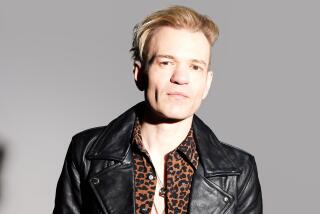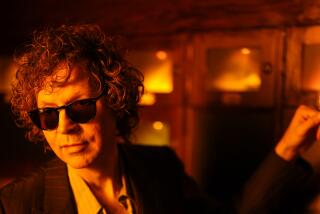CHRIS WHITLEY : His Moody Blues Burn at Candlelight Sessions
- Share via
When singer-guitarist Chris Whitley talks about house , he’s not referring to the neo-disco dance style known as house music. He means the New Orleans home studio of producer-musician Daniel Lanois where Whitley recorded his debut album, “Living With the Law,” just out on Columbia Records. And he speaks of that setting with something approaching reverence.
“The whole house influenced this record, all the people and the way they live there and stuff,” says the quietly intense Whitley. “The room there, it’s a big room, and the way they record, it’s not like a controlled environment. It’s more like setting yourself up to feel with the music.
“We recorded almost always late in the day into late evening, always with just candlelight. The singing I would do, some of it was just hand-held (microphone) standing in front of the monitors. The console is in this sort of ballroom, and I would just walk around with the music blasting out of the monitors and not worry about mike leakage and stuff.”
Lanois didn’t produce the album, but in that role his keyboardist, Malcolm Burn, elicited the kind of atmospheric sound associated with such Lanois clients as U2 and Peter Gabriel--though its density is more reminiscent of Lanois’ own critically admired album “Acadie.” It seems like the perfect realization of Whitley’s moody, folk-blues material.
“I feel like I come out of blues, real early Chicago blues, where it’s still got its country thing,” says Whitley, 30. “It’s not as formed as later blues stuff. . . . Early Howlin’ Wolf, early John Lee Hooker are wonderful ‘cause there’s so much discrepancies and they’re not concerned so much with the correctness of it.”
Whitley--who will be the opening act on the first leg of Tom Petty’s upcoming U.S. tour--came full circle to this style, rejecting the electro-pop and funk-rock he’d played during a six-year stay in Belgium. Dissatisfied, he returned to solo slide guitar and his early roots, and when he got back to New York in 1988 he found a receptive environment.
“I think it’s a timing thing,” he muses. “There must be something that people lack. There’s a sort of tendency toward this dirtier thing. Young, upwardly mobile people wear blue jeans. I wonder why people get into blues now, why Harley-Davidsons are popular. There’s something happening that’s curious. Sometimes I think I understand it. On the other hand, I don’t know.”
More to Read
The biggest entertainment stories
Get our big stories about Hollywood, film, television, music, arts, culture and more right in your inbox as soon as they publish.
You may occasionally receive promotional content from the Los Angeles Times.









